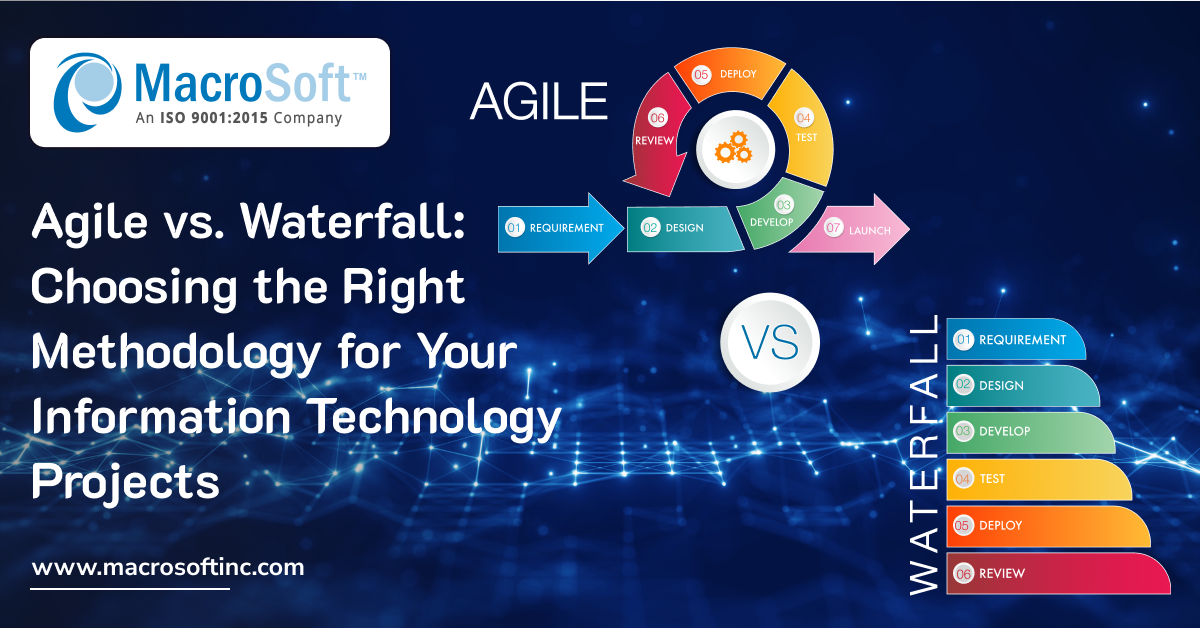

In the rapidly evolving realm of Information Technology (IT) projects, the selection of an appropriate project management methodology holds paramount importance for achieving success. Here at Macrosoft, we use the methodology that best fits our customer needs. There are two prominent methodologies, Agile and Waterfall, which present distinctive approaches to project execution, each accompanied by its own set of merits and drawbacks. Familiarizing oneself with the disparities between Agile and Waterfall is indispensable for IT project managers aiming to make well-informed decisions regarding the methodology best suited to their project requisites.
Agile Methodology: Flexibility and Adaptability
Agile methodology embodies an iterative, incremental, and collaborative modus operandi in project management. Within Agile frameworks, projects are dissected into smaller increments or sprints, fostering close cooperation among cross-functional teams to deliver incremental value. Noteworthy features of Agile encompass:
Flexibility: Agile accommodates change, allowing real-time adjustments throughout the project lifecycle in response to evolving requirements or feedback.
Continuous Improvement: Routine retrospective meetings facilitate team reflection on processes, fostering continuous enhancements that bolster efficiency and effectiveness.
Stakeholder Involvement: Agile advocates for active engagement of stakeholders throughout the project journey, ensuring their inputs are seamlessly integrated into the product development process.
Agile proves particularly adept for IT projects characterized by intricate requirements, elevated uncertainty, and a requisite for expedited delivery. It empowers teams to promptly adapt to shifting market conditions and evolving customer needs, progressively delivering value with each iteration.
Waterfall Methodology: Structure and Predictability
Waterfall methodology adheres to a linear and sequential project management approach, whereby each project phase is meticulously executed before transitioning to the subsequent stage. Typically, these phases encompass requirements gathering, design, implementation, testing, deployment, and maintenance. Salient features of Waterfall include:
Predictability: Waterfall furnishes a structured framework, endowing projects with predictability in terms of timelines, milestones, and deliverables.
Documentation: Waterfall mandates comprehensive documentation at each project stage, ensuring clarity and fostering accountability throughout the project lifecycle.
Stakeholder Engagement: While Waterfall may entail less frequent stakeholder involvement compared to Agile, it nevertheless allows for stakeholder input and feedback at pivotal milestones.
Waterfall emerges as an optimal choice for IT projects characterized by well-defined requirements, minimal anticipated changes throughout the project lifecycle, and an emphasis on stability and predictability.
Choosing the Right Methodology for Your IT Project
When deliberating between Agile and Waterfall for an IT project, several factors warrant consideration:
Project Requirements: Evaluate the level of uncertainty and volatility in project requirements. Agile proves well-suited for projects characterized by evolving requirements, whereas Waterfall aligns better with projects featuring stable and well-defined requisites.
Team Dynamics: Factor in the size and composition of your project team. Agile necessitates close collaboration and self-organizing teams, whereas Waterfall may be more conducive to teams preferring structured delineation of roles and responsibilities.
Customer Collaboration: Assess the extent of customer involvement and feedback required throughout the project. Agile facilitates regular customer collaboration and feedback, whereas Waterfall may involve less frequent customer engagement.
Organizational Culture: Reflect on your organization’s culture and readiness to embrace Agile practices. Agile necessitates a cultural shift towards flexibility, adaptability, and a culture of continuous improvement, while Waterfall resonates more with traditional hierarchical structures.
Conclusion
In conclusion, the selection between Agile and Waterfall methodologies for IT projects hinges on various factors, including project requisites, team dynamics, customer collaboration, and organizational culture. Agile offers flexibility and adaptability conducive to dynamic projects with evolving requirements, whereas Waterfall furnishes structure and predictability ideal for projects boasting stable and well-defined requisites. Ultimately, project managers must meticulously evaluate these factors to discern the methodology aligning best with their project goals and aspirations, thereby ensuring successful project delivery within the ever-evolving landscape of Information Technology.
By Talha Khan | March 25th, 2024 | General
Recent Blogs


The Peril of Fake Job Candidates in the Technology and IT Industry
Read Blog

Humanizing Automation: Fostering Collaboration in the Digital Era
Read Blog

Advantages of Technology and IT Companies Partnering with Staffing Firms Offering Visa Sponsorship
Read Blog


 Home
Home Services
Services




































